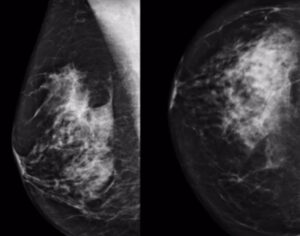Breast cancer is most commonly found on a mammogram. Mammograms unfortunately, like most diagnostic tests, are not perfect and can’t always catch the cancer. In fact, up to one in five women can have their cancer missed on a mammogram. Breast cancer is the commonest form of cancer that affects women and will affect one in eight women in their lifetime. Women with screen-detected cancer are mostly able to be completely cured and will go on to be long-term survivors. So we really need to improve the way we can diagnose and treat women with breast cancer.
Diagnosing breast cancer with a mammogram
Screening by using AI (artificial intelligence) is the answer. Breast screening has played a really important part in improving cancer outcomes across the world. There are two main challenges with diagnosing breast cancer with a mammogram. The first is a false negative or missing a cancer. There’s the other side of the equation, which is a false positive, which means we think they have cancer when they don’t actually have cancer.

Using AI on breast screening
Computers learn a lot like humans. They learn by example and in order to teach a computer how to interpret mammograms, we had to show it many, many examples – those that contain cancer and those that don’t. And we supervise it and we say these are the cases that are positive and these the cases are negative. And after many, many iterations and showing them and through trial and error, it will eventually learn to get things right. In an experiment, we had six radiologists look at all these cases and decide whether they thought cancer was present or not. We had the algorithm do the same task but it did much better. The most exciting part of this work is that we’re able to catch 9% more cancer at screening. Also very exciting is that we’re able to reduce the amount of false positives by 5.7%.

The mammogram above, shows a malignancy outlined in yellow that all six radiologist missed but our algorithm caught. However, there were also cases that all six radiologists caught but the algorithm didn’t. And so it’s clear that they’re making hopefully complimentary decisions, and we’re excited by the synergy of putting them two together. We definitely want to use this AI tool clinically. The best way to do that is to provide it as a tool to clinicians to use. In many cases with AI, using these tools allows clinicians to have significantly more free time to concentrate on what we all went to medical school for, which is to actually take care of patients. We’re excited about empowering radiologists with these tools and hoping they become ubiquitous, such as spellcheck now permeates your life. You wouldn’t think about writing an email without spellcheck. And we hope a doctor wouldn’t interpret a mammogram without the use of some AI assistance.


